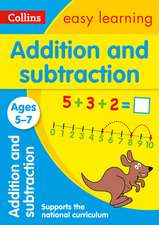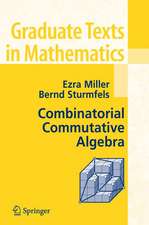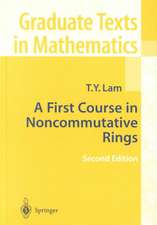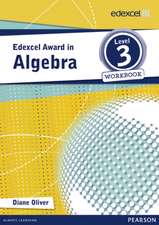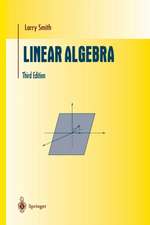Modular Representation Theory: New Trends and Methods: Lecture Notes in Mathematics, cartea 1081
Autor D. Bensonen Limba Engleză Paperback – sep 1984
After a short review of background material, three closely connected topics in modular representation theory of finite groups are treated: representations rings, almost split sequences and the Auslander-Reiten quiver, complexity and cohomology varieties. The last of these has become a major theme in representation theory into the 21st century.
Some of this material was incorporated into the author's 1991 two-volume Representations and Cohomology, but nevertheless Modular Representation Theory remains a useful introduction.
Din seria Lecture Notes in Mathematics
- 17%
 Preț: 360.42 lei
Preț: 360.42 lei -
 Preț: 459.92 lei
Preț: 459.92 lei -
 Preț: 121.41 lei
Preț: 121.41 lei -
 Preț: 175.68 lei
Preț: 175.68 lei -
 Preț: 197.00 lei
Preț: 197.00 lei -
 Preț: 279.76 lei
Preț: 279.76 lei -
 Preț: 477.65 lei
Preț: 477.65 lei - 17%
 Preț: 361.88 lei
Preț: 361.88 lei -
 Preț: 252.37 lei
Preț: 252.37 lei -
 Preț: 353.99 lei
Preț: 353.99 lei -
 Preț: 138.88 lei
Preț: 138.88 lei -
 Preț: 152.61 lei
Preț: 152.61 lei -
 Preț: 116.67 lei
Preț: 116.67 lei -
 Preț: 102.77 lei
Preț: 102.77 lei - 17%
 Preț: 365.52 lei
Preț: 365.52 lei -
 Preț: 396.75 lei
Preț: 396.75 lei - 17%
 Preț: 362.12 lei
Preț: 362.12 lei -
 Preț: 396.11 lei
Preț: 396.11 lei -
 Preț: 357.78 lei
Preț: 357.78 lei - 17%
 Preț: 362.31 lei
Preț: 362.31 lei -
 Preț: 403.80 lei
Preț: 403.80 lei - 17%
 Preț: 361.70 lei
Preț: 361.70 lei -
 Preț: 499.87 lei
Preț: 499.87 lei -
 Preț: 457.03 lei
Preț: 457.03 lei -
 Preț: 395.90 lei
Preț: 395.90 lei -
 Preț: 459.00 lei
Preț: 459.00 lei -
 Preț: 487.57 lei
Preț: 487.57 lei -
 Preț: 424.01 lei
Preț: 424.01 lei -
 Preț: 487.57 lei
Preț: 487.57 lei -
 Preț: 330.55 lei
Preț: 330.55 lei -
 Preț: 325.75 lei
Preț: 325.75 lei -
 Preț: 350.30 lei
Preț: 350.30 lei -
 Preț: 331.31 lei
Preț: 331.31 lei -
 Preț: 408.37 lei
Preț: 408.37 lei -
 Preț: 328.25 lei
Preț: 328.25 lei -
 Preț: 421.28 lei
Preț: 421.28 lei -
 Preț: 276.08 lei
Preț: 276.08 lei -
 Preț: 424.60 lei
Preț: 424.60 lei -
 Preț: 422.05 lei
Preț: 422.05 lei -
 Preț: 505.01 lei
Preț: 505.01 lei -
 Preț: 422.05 lei
Preț: 422.05 lei -
 Preț: 274.93 lei
Preț: 274.93 lei -
 Preț: 335.16 lei
Preț: 335.16 lei -
 Preț: 422.27 lei
Preț: 422.27 lei -
 Preț: 497.49 lei
Preț: 497.49 lei -
 Preț: 272.81 lei
Preț: 272.81 lei -
 Preț: 428.04 lei
Preț: 428.04 lei -
 Preț: 376.22 lei
Preț: 376.22 lei -
 Preț: 427.10 lei
Preț: 427.10 lei -
 Preț: 325.92 lei
Preț: 325.92 lei
Preț: 385.47 lei
Nou
Puncte Express: 578
Preț estimativ în valută:
73.76€ • 77.37$ • 61.40£
73.76€ • 77.37$ • 61.40£
Carte tipărită la comandă
Livrare economică 01-15 aprilie
Preluare comenzi: 021 569.72.76
Specificații
ISBN-13: 9783540133896
ISBN-10: 3540133895
Pagini: 248
Ilustrații: XII, 231 p.
Dimensiuni: 155 x 235 x 13 mm
Greutate: 0.35 kg
Ediția:1984
Editura: Springer Berlin, Heidelberg
Colecția Springer
Seria Lecture Notes in Mathematics
Locul publicării:Berlin, Heidelberg, Germany
ISBN-10: 3540133895
Pagini: 248
Ilustrații: XII, 231 p.
Dimensiuni: 155 x 235 x 13 mm
Greutate: 0.35 kg
Ediția:1984
Editura: Springer Berlin, Heidelberg
Colecția Springer
Seria Lecture Notes in Mathematics
Locul publicării:Berlin, Heidelberg, Germany
Public țintă
ResearchCuprins
Rings and Modules.- Modules for Group Algebras.
Textul de pe ultima copertă
The aim of this 1983 Yale graduate course was to make some recent results in modular representation theory accessible to an audience ranging from second-year graduate students to established mathematicians.
After a short review of background material, three closely connected topics in modular representation theory of finite groups are treated: representations rings, almost split sequences and the Auslander-Reiten quiver, complexity and cohomology varieties. The last of these has become a major theme in representation theory into the 21st century.
Some of this material was incorporated into the author's 1991 two-volume Representations and Cohomology, but nevertheless Modular Representation Theory remains a useful introduction.
After a short review of background material, three closely connected topics in modular representation theory of finite groups are treated: representations rings, almost split sequences and the Auslander-Reiten quiver, complexity and cohomology varieties. The last of these has become a major theme in representation theory into the 21st century.
Some of this material was incorporated into the author's 1991 two-volume Representations and Cohomology, but nevertheless Modular Representation Theory remains a useful introduction.


